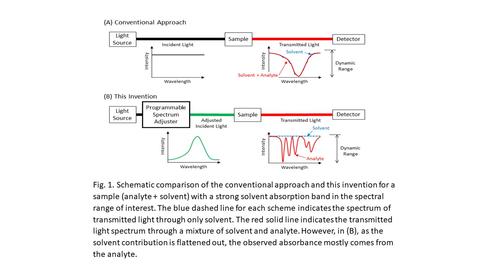Problem
Patent Description
This invention is a spectroscopic method that adjusts the incident light intensity as a function of wavelength to flatten the solvent-only transmitted light spectrum over an interesting wavelength range. When a solvent has a strong absorption band within an interesting spectral region of analytes, a limited dynamic range of the detection system is dominated by the strong solvent absorption. This requires not only very thin optical pathlength but also very high analyte concentration. For example, due to the strong water absorption in the mid-IR range, aqueous protein samples should be prepared in a 6 or 8 um thick sample holder, and protein concentration should be as high as its solubility. This invention is intended to minimize the solvent contribution to the dynamic range of the detection system and to maximize the sensitivity of analyte-only absorbance, which can increase the available sample thickness and enhance the detection limit of analytes.

Invention
A spectrum adjuster produces a pure analyte spectrum and includes: a dynamic opacity optic that receives input light, receives an adjustment signal, produces primary adjusted light, and produces secondary adjusted light from the input light based on the adjustment signal; a light source in optical communication with the dynamic opacity optic; a detector in optical communication with the dynamic opacity optic and that receives transmitted light from the sample and produces a transmitted light signal based on an amount of transmitted light received; and an adjustment controller that receives the transmitted light signal, produces the adjustment signal, and communicates the adjustment signal to the dynamic opacity optic.
Features
This invention is intended to minimize the solvent contribution to the dynamic range of the detection system and to maximize the sensitivity of analyte-only absorbance, which can increase the available sample thickness and enhance the detection limit of analytes.

